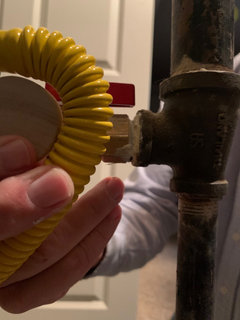New furnace takes 2.5 hours to warm house
David Hottman
3 years ago
Featured Answer
Sort by:Oldest
Comments (97)
kevin9408
3 years agoAustin Air Companie
3 years agolast modified: 3 years agoRelated Discussions
How many hours labor does it take you to make
Comments (6)I make about 4.5 cu yards annually. Estimate that I enjoy 300 hours of pleasure in doing so and don't have to pay for the experience. So thatÂs about 66 hours per yard. 85 % of the material comes from off site. Leaves and green grass clippings come from the townÂs lawn refuse area located 2 miles away. Frequently combine trips in the pickup with other errands. Two sources for horse manure one 5 miles away, the other two miles off the direct route to the mother-in-laws house. I Always combine trips there. Recently I have been making more than enough for my needs and give away about half a yard or so every year. I know I could get 10 yards of so called compost dropped in my driveway for $30.00 per yard plus delivery of probably $60.00 or so. But it wouldnÂt be as good as my own home made stuff and I would have been deprived of the pleasure of making the absolute best homemade compost it the state of Michigan except for maybe one guy who might also make some good stuff if he doesnÂt let it get too wet. And finally, no. It does not costÂs more to make the very best compost than it would to purchase some compost like material. But the labor and time involved is significant and therefore only worth it if you enjoy the endeavor. Most consumers do not know what hi quality compost looks like and can easily be sold material that is said to be compost but might actually be leaf mulch, aged horse or cow manure, combination of those things sometimes mixed with soil or sand to command an ever higher price. All of the above being said, If you have to buy it then go ahead and buy it. Just look at it first and make sure that it is suitable for your needs before having a dump truck load of the stuff dumped in your driveway. Bill Hill...See MoreNew furnace can't keep up
Comments (4)The new furnace is 20K BTU less heat output. Efficiency ratings ... 80% old vs. 96% new ... has no bearing on the heat output, right? The new one is still 70K and the old one was 90K. That being said, 68ðF indoors when outside is -20ðF doesn't seem bad to me. That's an 88ðF increase between outside and in. What indoor temp did the installer target when he calculated the capacity?...See MoreHVAC/Forced Gas furnaces for new custom home
Comments (39)If both furnaces are installed in the basement, more rigid duct work would have to be installed, but the lineset and the wiring would shorter. I don't think there would be much difference in materials. There would be more labor. It takes more work to run the duct work up from the basement versus running flexible ducts in the attic. I have no way of estimating this. I would think an extra 2-3 days of labor should do it, but I could be way off. The plans would have to modified. You second quote for the HVAC equipment is $21,850, not $26,000. I like the second quote with the 2-stage furnaces. Remember this quote is for over sized furnaces and condensers. I don't understand why there is a separate quote for gas lines. Is this considered an option? I am not convinced you need a humidifier. You can always get a stand alone dehumidifier later if you need it. The kitchen hood is good if you like to cook....See Morecracked flame sight glass on warm-air furnace
Comments (6)I found a local dealer willing to sell me the sight glass (it's actually Pyrex) and a matching gasket for about 20 bucks. Although there were lower prces out there, most shops sell only to those licensed in the trade. Oh the irony. The burner tech who caused the damage has agreed to cover the cost of the parts - as long as I install them. We'll see if he pays as promised when they arrive next week. mr.havac... I asked the burner tech to downsize the nozzle to save a bit on fuel. I made extensive improvements to the ductwork layout and tripled the ceiling insulation when the furnace went in. Since then, I have suspected that the system was just a bit oversized. I'll know for sure this winter! BTW...I've earned the right to be a royal PITA. Do you remember when I installed that furnace almost two years ago? The oil tank, fuel line, fill/vent piping, flue pipe, and nealy all of the ductwork got replaced, as well. The plenums were bent and cut according to scale plans I drew up. I ran new 12/2 through a new heat fuse and wired it. I even added a vent alarm (the oil deliveryman appreciated that one). I pulled a mechanical permit - signed by the town building inspector (cost of permit - 20 bucks, peace-of-mind - priceless). Everything is to code. This was a soup-to-nuts DIY install. All of this work is no big deal to someone who does this for a living. However, it's a helluva big deal to me. So yeah I'm picky. I didn't spend all that time and money doing it right only to have a PAID professional screw it up. The sight glass is right over the gun with a crack going down the middle. I can easily feel the crack, as the glass on one side of it is now higher then the other. So the crack is really a split - held together with two screws by the bezel and gasket. There's no doubt that the glass will come out in two pieces when the assembly is removed. Would you allow a furnace to run like this over a season? Would you charge a customer 100 bucks for this kind of work?? miken_2008... The furnace is a Crown CLBR 68-112. BTW...mr.havac is right about the link in your sig; It shouldn't be there. Peace. Marco...See MoreDavid Hottman
3 years agoDavid Hottman
3 years agokevin9408
3 years agolast modified: 3 years agoDavid Hottman
3 years agoElmer J Fudd
3 years agolast modified: 3 years agomike_home
3 years agoDavid Hottman
3 years agomike_home
3 years agoDavid Hottman
3 years agokevin9408
3 years agoAustin Air Companie
3 years agoDavid Hottman
3 years agoDavid Hottman
3 years agoAustin Air Companie
3 years agolast modified: 3 years agoDavid Hottman
3 years agomike_home
3 years agoDavid Hottman
3 years agoAustin Air Companie
3 years agolast modified: 3 years agoDavid Hottman
3 years agoAustin Air Companie
3 years agolast modified: 3 years agoAustin Air Companie
3 years agokevin9408
3 years agolast modified: 3 years agoDavid Hottman
3 years agoDavid Hottman
3 years agoDavid Hottman
3 years agoAustin Air Companie
3 years agomike_home
3 years agoDavid Hottman
3 years agoAustin Air Companie
3 years agolast modified: 3 years agomike_home
2 years agoDavid Hottman
2 years agoDavid Hottman
2 years agoDavid Hottman
2 years agoAustin Air Companie
2 years agoDavid Hottman
2 years agomike_home
2 years agolast modified: 2 years agoElmer J Fudd
2 years agoDavid Hottman
2 years agoElmer J Fudd
2 years agoAustin Air Companie
2 years agolast modified: 2 years agomike_home
2 years agoDavid Hottman
2 years agoElmer J Fudd
2 years agoAustin Air Companie
2 years agokevin9408
2 years agoElmer J Fudd
2 years agolast modified: 2 years agoAustin Air Companie
2 years agolast modified: 2 years agoElmer J Fudd
2 years agolast modified: 2 years ago
Related Stories

DECLUTTERING5 Ways to Jump-Start a Whole-House Decluttering Effort
If the piles of paperwork and jampacked closets have you feeling like a deer in the headlights, take a deep breath and a baby step
Full Story
THE POLITE HOUSEThe Polite House: How to Take Charge When Hosting Houseguests
Part 2: When overnight guests arrive, follow this advice to set guidelines on eating out, seeing attractions and more
Full Story
HOW TO PHOTOGRAPH YOUR HOUSETake Great Home Photos the Easy Way — 5 Tips From a Pro
Improve your for-sale ad or just make beautiful memories with these simple strategies anyone can use
Full Story
HOUZZ TOURSHouzz Tour: A Brooklyn Townhouse Takes a Warm, Contemporary Turn
Softening a traditional boxy shape creates better access and a more interesting look for a Brooklyn family home
Full Story
COLORWarm Up to White All Around the House
Explore the many ways to design a white kitchen, bathroom, dining room or bedroom that's far from stark and sterile
Full Story
FLOWERS5 Sensational Flowering Vines for Warm Climates
Splash your garden with bright tropical color from late summer through fall with these showy trailing and climbing beauties
Full Story
COMMUNITYTogetherness Take 2: Is a Cohousing Community for You?
Missing that sense of connection? Consider the new breed of neighborhood with a communal bent
Full Story
EXTERIOR COLORChoosing Color: 1 House, 5 Exterior Paint Palettes
See how color variations change the look of this midcentury ranch-style home
Full Story
PET PLACESPet’s Place: Cat Furniture Creations Take Over the House
Owners get creative with furniture for their cats, and the ideas lead to a business
Full Story
CONTEMPORARY HOMESHouzz Tour: Contemporary Canadian Lake House Warms and Welcomes
A northern Ontario home accommodates parties of 100 but is cozy enough for two
Full Story








kevin9408